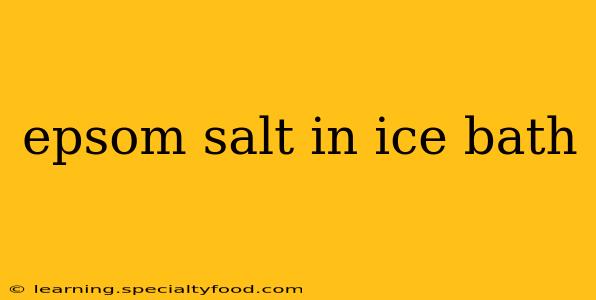Epsom salt, chemically known as magnesium sulfate, has gained popularity as an addition to ice baths. While ice baths themselves offer numerous benefits, adding Epsom salt is believed to enhance these effects. But does it truly work, and what precautions should you take? Let's delve into the details.
What are the benefits of using Epsom salt in an ice bath?
Many athletes and individuals focused on recovery swear by the combination of ice and Epsom salt. The purported benefits stem from the properties of both ingredients:
-
Ice Bath Benefits: Ice baths, or cold water immersion (CWI), are known to reduce muscle soreness and inflammation, improve circulation, and potentially speed up recovery after intense physical activity. They help constrict blood vessels, reducing swelling, and then, upon warming, dilate them, increasing blood flow and nutrient delivery to muscles.
-
Epsom Salt Benefits: Epsom salt is rich in magnesium, a mineral crucial for muscle function, nerve transmission, and various metabolic processes. When dissolved in water, it's believed to allow for transdermal absorption of magnesium, potentially supplementing levels and reducing muscle cramps and soreness. The sulfate in Epsom salt is also thought to help flush toxins from the body.
Combining these, the theory is that Epsom salt enhances the anti-inflammatory and muscle recovery effects of an ice bath by boosting magnesium levels and potentially aiding detoxification. However, scientific evidence supporting the magnitude of these benefits specifically from transdermal magnesium absorption is still limited and requires further research.
How much Epsom salt should I add to my ice bath?
There's no universally agreed-upon amount. A common starting point is approximately 2 cups of Epsom salt per 10 gallons of water. However, you can adjust this based on personal preference and the size of your ice bath. Start with a smaller amount and gradually increase it until you find a concentration you find comfortable.
Does Epsom salt increase the cooling effect of an ice bath?
No, Epsom salt itself does not significantly alter the temperature of the water. Its main contribution is the potential added benefits from the magnesium and sulfate. The cooling effect remains primarily determined by the amount and temperature of the ice used.
Can Epsom salt irritate my skin?
While generally safe, Epsom salt can irritate sensitive skin, especially if used in high concentrations. It's advisable to start with a smaller amount and monitor your skin's reaction. If you experience any irritation, redness, or burning, discontinue use and rinse thoroughly. Individuals with pre-existing skin conditions should consult a doctor before using Epsom salt in an ice bath.
What are the potential downsides of using Epsom salt in an ice bath?
Aside from potential skin irritation, other potential downsides are:
- Individual Reactions: Some individuals may experience allergic reactions or sensitivities to Epsom salt.
- Dehydration: Prolonged ice baths can lead to dehydration. Ensure you rehydrate adequately before, during, and after your immersion.
- Overdoing it: While beneficial for recovery, excessive ice bath use can be counterproductive. Listen to your body and avoid overdoing it.
Is it safe for everyone to use Epsom salt in an ice bath?
While generally considered safe for healthy adults, it's crucial to consult your doctor before incorporating Epsom salt into your ice bath routine, especially if you:
- Have any underlying health conditions, such as kidney disease or heart problems.
- Are pregnant or breastfeeding.
- Have sensitive skin or a history of skin allergies.
By understanding the purported benefits, proper usage, and potential precautions, you can determine if incorporating Epsom salt into your ice bath routine is right for you. Remember to always prioritize listening to your body and consulting a healthcare professional when necessary.
